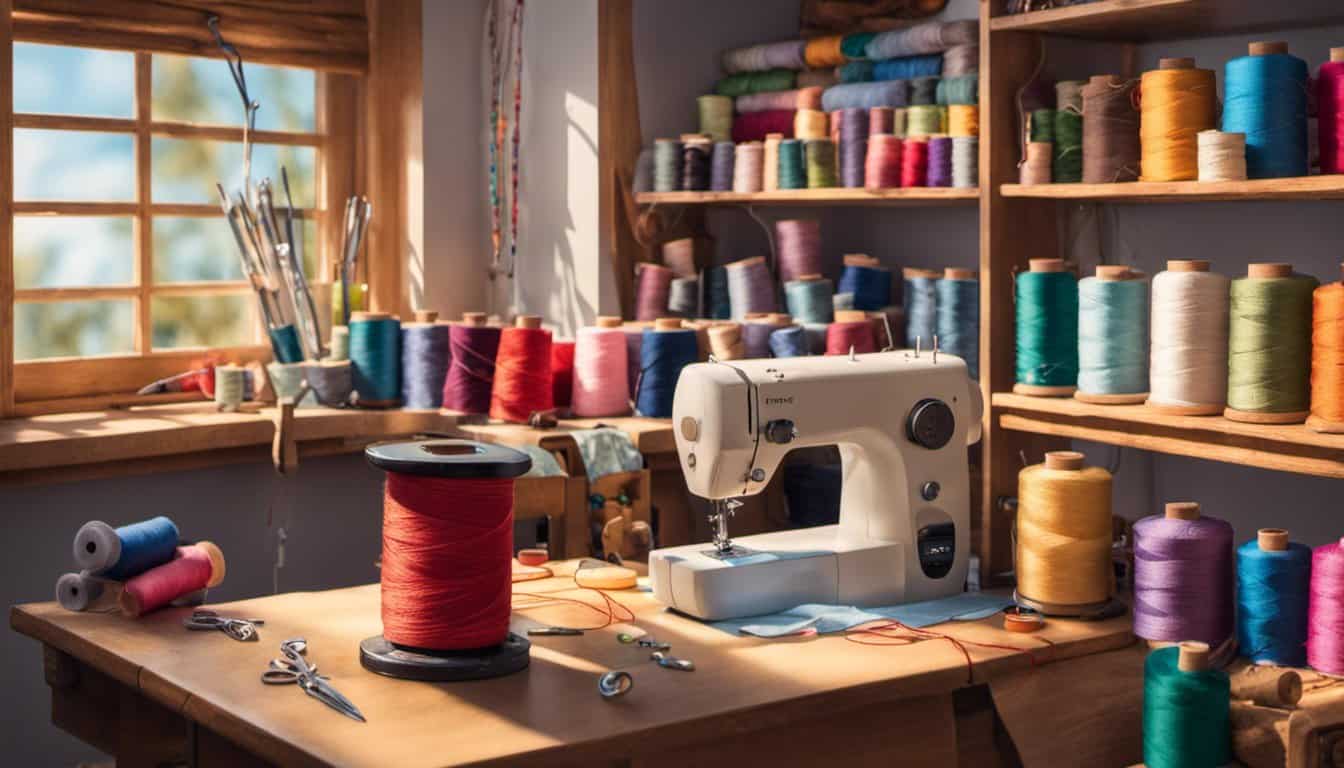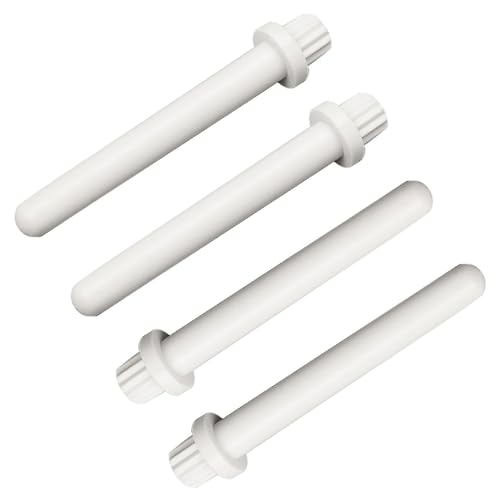So, you’ve got your brand new sewing machine sitting on the table in front of you. It’s glossy and gleaming, just waiting to help you create something beautiful. But wait! Before you dive headfirst into your next DIY project, there’s one thing that’s absolutely crucial – choosing the right thread for your sewing machine.
Now, I know what you’re thinking: “Thread is thread, right? Can’t I just use any old kind?” Well, not exactly. The type of thread you use can make a significant difference in the quality of your stitches and ultimately the finished product. Selecting an inappropriate thread might lead to skipped stitches or even damage your precious sewing machine!
You may be surprised to learn that not all threads are created equal. They come in various materials like cotton, polyester and silk; each with its own strengths and weaknesses depending on the fabric being used and the project at hand. So don’t worry if it feels overwhelming at first – we’re here to guide you through this thready maze!
Understanding the Importance of Thread for Sewing Machine
So you’ve got your sewing machine, you’re all set with your fabric, but wait! What about the thread? Believe it or not, picking a thread for your sewing machine isn’t just about matching colors. It’s a lot more important than you might think.
The first thing to understand is that your choice of thread can dramatically affect the quality of your stitches. Think about it – if you’re using a flimsy thread on heavy-duty fabric, it’s bound to break. On the other hand, using thick thread on delicate fabrics may cause puckering or even tear the material. So getting that perfect match between fabric and thread is super crucial.
“But how do I know what kind of thread to use?” Good question! Threads come in a variety of materials like cotton, polyester, silk and so much more. As a rule of thumb,
- Cotton threads are great for quilting and embroidery
- Polyester threads work well for almost anything since they’re strong and durable
- Silk threads are perfect when working with delicate fabrics as they glide smoothly without damaging them
Now let’s throw some numbers at this! For regular home sewing machines – which most likely includes yours – 40 weight (wt) threads are typically used. This number refers to how thick or thin the thread is: higher numbers mean thinner threads while lower numbers refer to thicker ones.
Furthermore, did you know that not every needle works with every type of thread? That’s right! Each needle has an eye size designed specifically for certain types and sizes of threads. For example:
- Small-eyed needles work best with fine threads
- Medium-eyed needles are suitable for medium-weight threads
- Large-eyed needles can accommodate heavier weight threads
In conclusion (oops!), don’t overlook the importance of choosing the right type and size of thread when using your sewing machine. It’s not just about aesthetics – it also plays a significant role in ensuring the durability and quality of your sewing projects.
Types of Threads Suitable for Sewing Machines
Before you dive into your next sewing project, take a moment to consider the thread you’re using. It’s not just about color or thickness; different types of threads have unique properties that can affect the quality and durability of your stitches.
First up is cotton thread. Loved by quilters around the globe, this natural fiber is soft yet strong, making it ideal for projects involving lightweight fabrics like cotton and linen. However, keep in mind that it has little elasticity so it might not be your go-to choice for stretchy materials.
Next we have polyester thread. It’s an all-rounder and works well with almost any fabric due to its high strength and flexibility. Fun fact: polyester threads are often coated with a wax or silicone finish which allows them to glide through fabric more easily!
Let’s move on to nylon thread now. This synthetic option is known for its high strength and elasticity which makes it suitable for sewing stretchy fabrics like knits or elastic textiles. One thing to remember though, nylon thread can melt under high heat so be careful when ironing!
Ever heard of silk threads? These are perfect if you’re working with delicate fabrics such as silk itself or wool because they’re very gentle on fabric fibers while providing strong seams.

Lastly, let’s talk about rayon thread! Known primarily for their glossy finish, they’re usually used in embroidery work due to their beautiful sheen.
- Cotton Thread
- Polyester Thread
- Nylon Thread
- Silk Thread
- Rayon Thread
Remember that choosing the right type of thread isn’t merely a matter of preference; it could mean the difference between a successful sewing project and one that falls apart at the seams (literally!). So next time you sit down at your sewing machine, give some thought to what type of thread will best serve your project.
How to Choose the Right Thread for Your Sewing Machine
So, you’ve got your sewing machine all set up and ready to go. Next step? Finding the perfect thread! It’s not as simple as grabbing any old spool off the shelf. There are factors you’ll need to consider, like fabric type, project complexity, and even your machine’s personality.
First things first – we’re talking about fabric type. If you’re working with heavyweight materials like denim or canvas, a strong thread such as nylon or polyester will be your best bet. On the other hand, delicate fabrics like silk or chiffon call for finer threads – think cotton or rayon.
- Heavyweight Fabrics: Use Nylon or Polyester
- Delicate Fabrics: Opt for Cotton or Rayon
Now let’s delve into project complexity. Are you whipping up some simple curtains or tackling an intricate quilt? For basic projects, an all-purpose polyester thread is usually a safe choice. But for those detailed endeavors requiring lots of tight stitches (we’re looking at you, quilters!), a thinner cotton thread could save the day.
- Simple Projects: All-Purpose Polyester does the job
- Complex Designs: Thin Cotton Thread is your friend
« How to Clean Sewing Machine: Your Easy Guide for a Smooth-Running Stitcher
Can I Bring Sewing Needles on a Plane? Your Travel Questions Answered »
Last but not least: listen to your machine! Some machines have distinct preferences when it comes to certain types of threads. If yours seems to struggle with a specific kind – maybe it’s breaking frequently or creating uneven stitches – don’t be afraid to switch it up and try something new.
Remember: The right thread can make all the difference in your sewing results! So put some thought into it next time you’re threading that needle – trust us, both your sewing machine and future projects will thank you.
Step-by-Step Guide: Threading Your Sewing Machine Correctly
Ever faced the frustration of mid-sewing machine breakdowns? Often, it’s all down to incorrect threading. Here’s your foolproof guide to achieving perfect threads every time.
First off, you’ll want to make sure your sewing machine is turned off – safety first! After that, place your spool of thread on the spool pin. It usually sits at the top right of your sewing machine. Now, locate the thread guide – it’s a small metallic piece sticking out near the spool pin.
Next up, pull out some thread and lead it through this guide. From here, you’re going to bring it downwards towards another metallic piece called ‘tension discs’. Make sure you slip the thread between these tension discs.
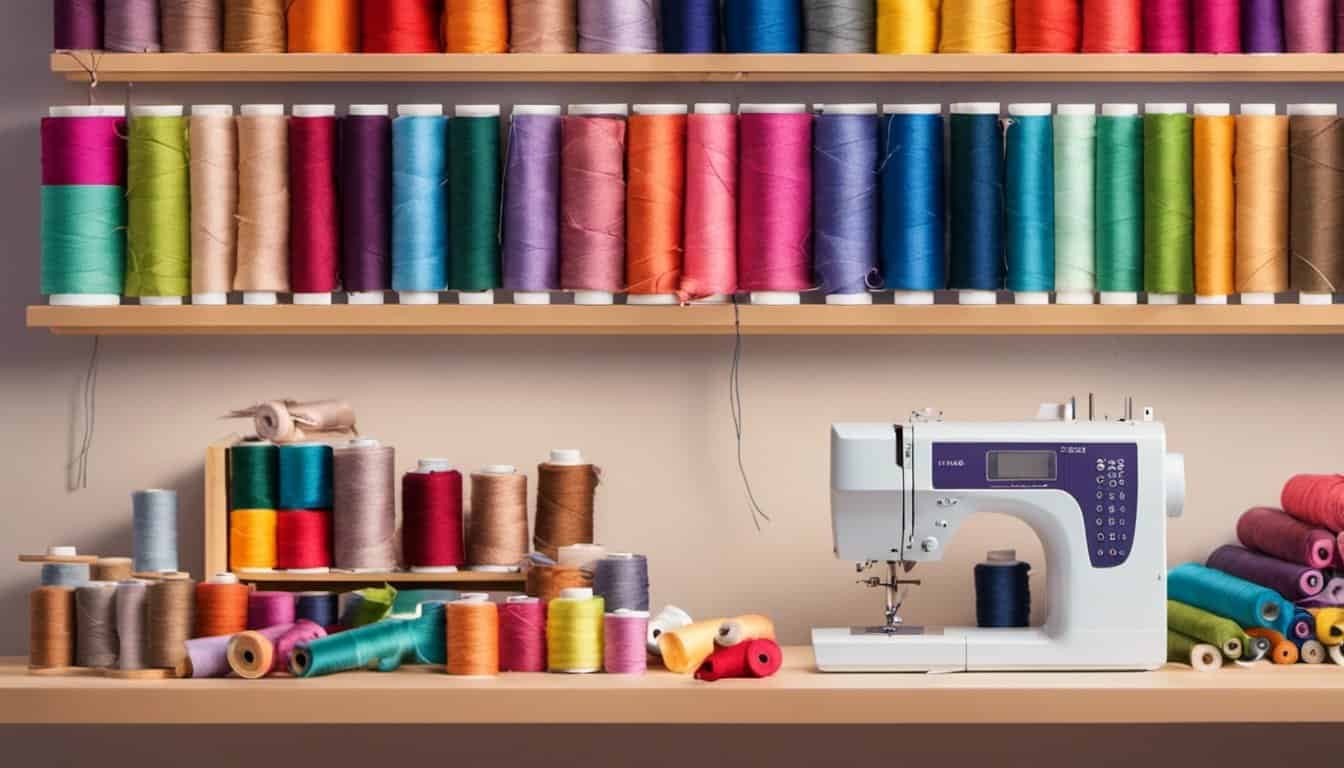
Now comes one tricky part: threading the take-up lever. This part moves up and down when you manually turn your sewing wheel (the large circular part on the side). You need to pull your thread from left to right through this tiny hole in the lever.
Alright, almost there! The last step is threading the needle itself. Most machines come with an automatic needle-threader which makes this step a breeze but if yours doesn’t have one – don’t fret! Just cut a clean edge on your thread and pass it through from front-to-back.
Here’s a quick recap:
- Turn off machine
- Place spool on pin
- Thread goes through guide
- Thread slips between tension discs
- Thread passed through take-up lever
- Finally threaded through needle
Remember practice makes perfect so don’t get disheartened if you struggle initially. Soon enough threading will be second nature. Happy stitching!
Common Problems with Threading a Sewing Machine and How to Fix Them
You’re ready to start your next sewing project, bobbin in hand, when suddenly you realize that something’s not quite right. Your machine isn’t stitching properly, or worse yet, not at all! Before you let frustration take over, it might comfort you to know that threading issues are among the most common problems faced by sewing enthusiasts. But don’t worry! Let’s walk through some of these hiccups and explore how we can fix them.
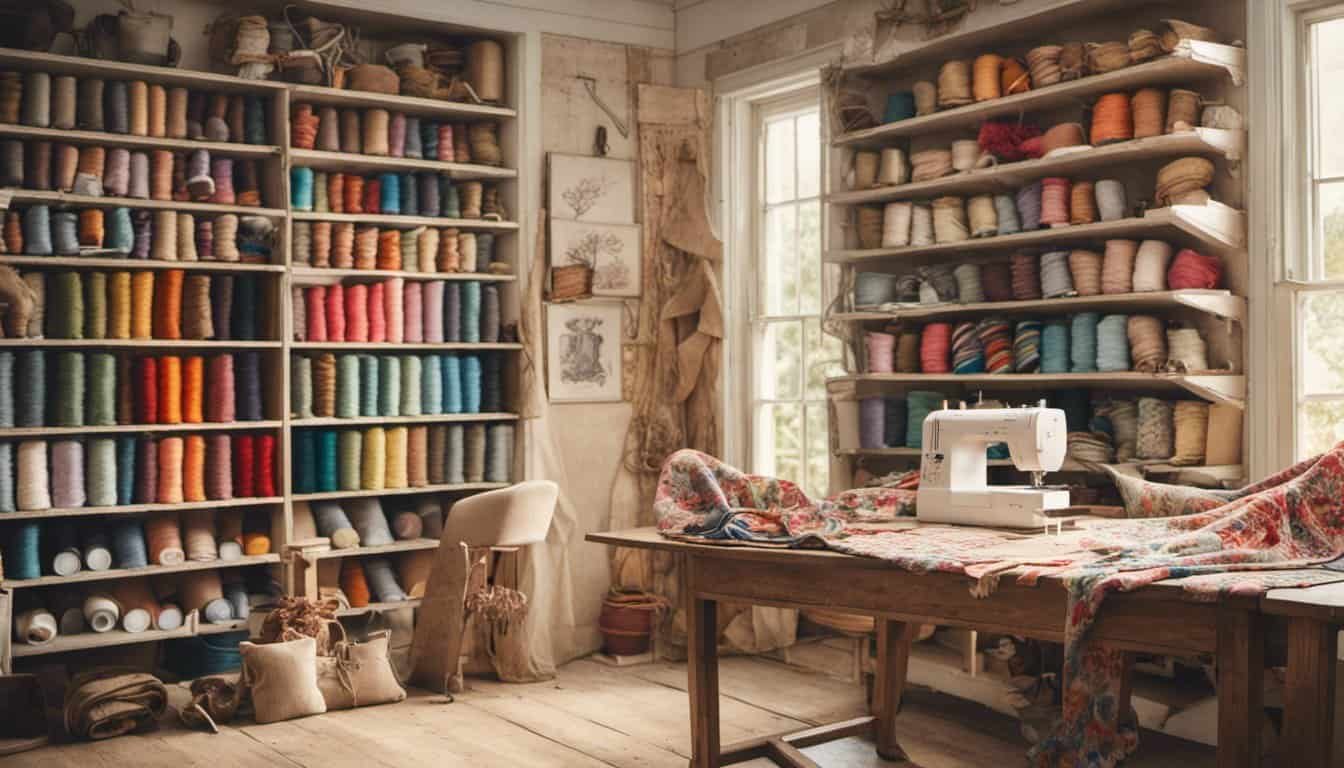
First off is the dreaded ‘thread bunching up under your fabric’. It’s like a nasty surprise waiting for you after running what seemed like a perfect stitch. This often happens when the machine isn’t threaded correctly. Here’s what you should do:
- Re-thread the machine: Sounds simple but trust me, it works more often than not.
- Check tension settings: If your thread tension is too tight or too loose, it may cause this issue.
Then there’s the ‘thread keeps breaking’ scenario which is enough to make even seasoned sewers want to pull their hair out. Here are some tips if this is happening on your watch:
- Ensure correct threading: Incorrect threading can lead to breakage.
- Use good quality thread: Poor quality thread tends to break easily.
Next up – ‘stitches skipping’. It feels like your machine just decided to go free-style on your fabric! Well, here are some steps that could help restore order:
- Change needle: A bent or blunt needle can cause skipped stitches.
- Adjust tension settings: Yes again! Unbalanced tensions could be causing those freewheeling stitches!
Last but definitely not least – ‘machine won’t pick up bobbin thread’. When this happens:
- Check bobbin placement: Make sure it’s installed correctly.
- Clean lint from bobbin area: Accumulated lint can interfere with picking up threads.
So, there you have it. Those are some of the most common threading issues you might face and some handy ways to fix them. Remember, patience is key when dealing with these pesky problems! Keep your cool, take a deep breath, and tackle each issue one at a time. You’ve got this!
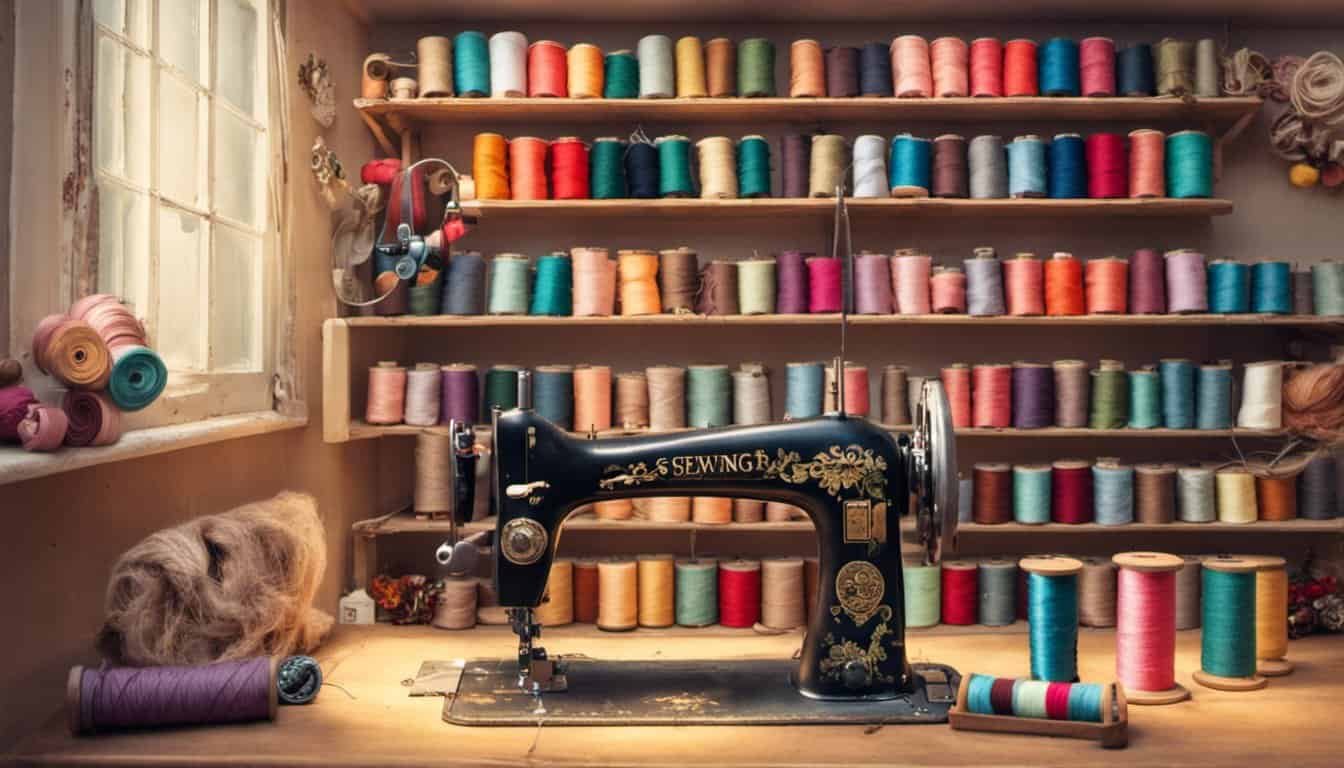
Best Brands of Thread for Sewing Machines
Let’s dive right into the world of sewing threads! When it comes to quality, not all thread brands are created equal. So, you’re in luck as we’re about to break down some of the top-notch choices out there.
First up on our list is Gutermann. They’ve been around since 1864 and we’ll tell ya why they’re still going strong. It’s the incredible variety they offer that really steals the show. From cotton, silk, and polyester to even specialty threads like metallics and glow-in-the-dark – Gutermann has got your back!
Next in line is Coats & Clark. You might know them better for their zippers but trust us, their thread game is just as strong! They boast a wide range of materials including cotton, polyester, rayon, and nylon. Plus with over 250 colors available in their Dual Duty XP General Purpose thread series alone? Well let’s just say your color matching worries are officially over.
Don’t forget about Aurifil either! Hailing from Italy with a lineage dating back to 1957, this brand specializes in premium cotton threads loved by quilters worldwide.
Here are other noteworthy mentions:

- Sulky: Known for decorative threads perfect for embroidery.
- Madeira: A go-to choice for machine embroidery enthusiasts.
- Brother: While more known for machines themselves, their embroidery thread line doesn’t disappoint.
Below is a quick summary:
| Brand | Specialties |
|---|---|
| Gutermann | Variety of types and colors |
| Coats & Clark | Wide material range and color options |
| Aurifil | Premium cotton threads |
| Sulky | Decorative threads |
| Madeira | Preferred by machine embroidery fans |
| Brother | Quality embroidery threads |
Remember though – what works best can depend on your specific project needs. But armed with these top-tier brands, you’re well on your way to sewing success!
Thread Maintenance Tips for Long-lasting Sewing Machine Performance
So, you’ve got yourself a sewing machine and you’re ready to create some beautiful pieces. But wait! Don’t forget about maintaining your thread—it’s an essential part of keeping your machine running smoothly. Here are some handy tips:
Firstly, let’s talk about cleaning. Just like any tool, threads collect dirt and dust over time. This grime can clog up your sewing machine if not properly taken care of. So how do you keep it clean? Easy peasy! Simply use a soft brush or canned air to gently remove any debris from the surface of the thread spool.
Next up is storage—you gotta protect those threads! Always store them in a cool, dry place away from direct sunlight. Heat can weaken thread over time and sunlight may fade the colors. Consider using plastic containers with lids for extra protection against dust and moisture.

Now onto quality—don’t skimp out on this one! High-quality threads might cost a bit more but they’ll save you headaches (and heartbreaks) down the line. They produce less lint which means less cleaning for you and smoother operation for your sewing machine.
Lastly, always check the thread tension before starting your project. Incorrect tension isn’t just frustrating—it could also cause damage to both the thread and your beloved sewing machine! If it’s too tight, loosen it up a little; if too loose, tighten that baby up!
Remember these simple tips will ensure long-lasting performance of your sewing machine while keeping those creative juices flowing smoothly!
Conclusion: Enhancing Your Crafting Experience with Quality Threads
Let’s wrap things up, shall we? You’ve got the inside scoop on threads for your sewing machine and you’re ready to take your crafting game to a new level. It’s all about making informed choices that suit both your machine and your project.
Quality matters, so don’t skimp on it! Opt for a high-quality thread that can stand the test of time. High-quality threads have a smoother surface which means less lint in your machine. Plus, they provide stronger stitches that are more durable.

Here’s what you need to remember:
- Polyester threads are versatile and strong, ideal for most projects.
- Cotton threads give an authentic look and feel to quilted projects.
- Silk threads are perfect for delicate fabrics like silk or wool.
Remember though, every project may demand a unique type of thread. So keep experimenting until you find what works best for each material.
A great sewing experience isn’t just about having quality tools or machines – though they certainly help! It’s also about patience, practice, dedication…and yes, the right kind of thread!
So go ahead, play around with different types of threads. Discover what works best with your sewing machine. In time, you’ll create masterpieces that not only look stunning but also last longer.
And who knows? Maybe there’s a masterpiece waiting just around the corner – all thanks to some quality thread and your incredible skillset!
